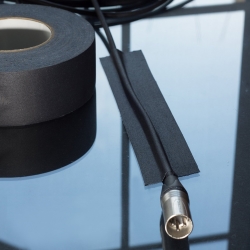Sure, you have a great microphone collection, the latest digital console, and fantastic loudspeakers – that’s everything required of a sound company, right? Well, not exactly.
The truth is that it’s the little things that can make the most significant difference between a “good” or “great” gig. Here’s a list of some (not all) of the “must haves” at any show, no matter how big or small.
—- Gaffer (“Gaff”) Tape – not “duct” (or “duck”) tape, or masking tape, or five-rolls-for-a-buck tape from the local swap meet. Gaff tape is the choice because it is purpose-designed for our applications while leaving little to no residue on cables, floors, carpets and most other surfaces. (The presentation is professional, there’s far less time needed for “de-gunking” cables in the shop, and clients appreciate the cleanliness.)
—- Proper Extension Cords – not the cheap orange or yellow cords from the local big box store. They don’t have the proper thickness of jacket and insulation for use in areas where people gather, like clubs and theatres.
—- The Right Cables – the National Electric Code (NEC) calls for Extra Hard Usage (SO) cables in areas where they may be subjected to physical damage, such as where people walk or carts roll over them. For locations where they’re not subject to physical damage, Hard Usage (SJO) cables should be the choice. In addition, utilize 10- or 12-gauge cables for longer runs because voltage drop occurs with distance. This effect is more pronounced the longer the cable and the smaller the wire gauge.
—- Spare Cables – including mic, instrument, loudspeaker and power varieties. Also carry different lengths in case a run is longer or shorter than expected. Also don’t forget barrel joiners for speakON and 1/4-inch terminated cables in case two need to be connected to extend a run.
—- Adapters – imagine the possibilities and then further understand that we can’t always imagine them all. For example (and “unexpectedly”) there may be a need to adapt a cable to interface the PA with a house system to feed sound to a lobby and/or underbalcony area. Also don’t forget turnaround adapters; these “gender benders” come in handy for switching the gender (male or female) of existing cables for intercoms, returning signals through snakes, and more.
—- 1:1 Transformer Isolation – a.k.a., “humbuckers” or ISO units, they use a transformer to break the physical connection between two pieces of gear that may be plugged into different outlets, which can cause noises like hum or buzz through a system. Think about a mixing console plugged in at front of house and powered loudspeakers plugged in at the stage area, a very common scenario.
—- The Right Booms – stock a decent assortment of shorter booms and/or adjustable length booms, as well as “shorty” mic stands. Long booms tend to stick out into the performance area, particularly when used on drums and instruments, and can get in the way of performers. Also stock a few round base stands, which come in handy for tight placement areas and for performers who prefer that style.
—- An Assortment Of Windscreens – they can make a huge difference on windy outdoor stages plus they help keep mics clean (i.e., from singers wearing lipstick). Further, windscreens of different colors help in keeping track of mics (and particularly wireless transmitters).
—- Extra Mic Clips – Mr. Murphy dictates that clips tend to break right before the show starts. Swapping them out is the easiest thing in the world – if you have spares on hand.
—- Music – clients don’t usually expect us to be DJs (unless that’s expressly why we were hired), but they do expect us to provide walk-in/out music and/or to play something light in the background during a dinner. Create and carry playlists of versatile tracks, particularly of the smooth jazz/soft rock/instrumental variety.
—- Utility Mixer – if the mixing console dies things can get dire really quick. Always carry a small backup (with at least 6 to 8 channels) as a potentially show-saving backup. It may not be big enough to handle every input, but that’s where our skills in routing come in, right?
Senior contributing editor Craig Leerman is the owner of Tech Works, a production company based in Las Vegas.















